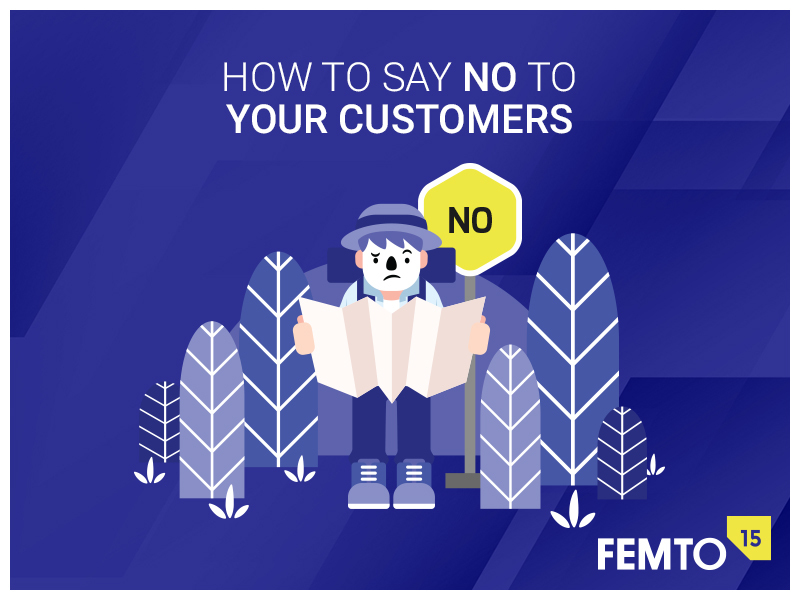
How to Say NO to Your Customers Without Being Rude
By Femto15 Team - November 4, 2019In this article, we take you from "the customer is always right" side to "do the right thing" side. If you are a fan of "Yes, and…" approach in customer service but have been drowned in the Yeses flood, or if you found that saying yes all the time breaks your business and burns out your customer service reps, this article will help you answer some questions around the topic.
Is the customer always right? Do customers have the right to accept all their requests with a big yes? If not, when and how should customer support reps say no?
Let's answer these questions!
Is the customer always right?
Customers are other human beings who live with us on the same planet. Human beings make mistakes, take the easy way out, have bad days, misbehave, become irrational, and do all the matters that people do.
These are trivial statements that don't need proof but should be in your mind while dealing with your customers. Being lauded with an enormous amount of rights defined for your customers is not a healthy thing for your business, nor your customer support reps.
We aren't saying that customers don't have rights, or that you should deal with them like enemies. We do neither tell you to prove them wrong or argue with them to win a debate.
We just tell you to put these facts in your mind while dealing with customers' requests. That way, you can analyze situations reasonably and decide the right thing to do away from any pressure, tense, or destruction.
When to say no to a customer?
When to say no is a policy that should be set in your company. Customer support reps should have a clear guide of when they can say no. Knowing the limits of what you can offer and what customers can have is the initial step. Here is a list of cases which may be your NO sign:
- Requesting something illegal.
- Customers ask you to do their work for them.
- Going against your business's values and ethics.
- Trying to deceive the company.
- Asking for unreasonable demands.
- Trying to strong-arm you.
- Being abusive, threatening, or insulting.
- Asking for things out of your business scope.
- Asking you to change your plans, offers, etc.
- Requesting a new feature/service you can't provide.
But how can you write your own list? How do you determine the situations at which you need to say no?
You can split them into two groups; things against ethics, and others against your business. Anything that doesn't match your business's values or respect your employees should be a red sign, and anything that damages your resources –including your reps time- or conflict with your plans and scope is another red sign.
How to say no to a customer?
It's Not What You Say, It's How You Say It.
That's very true when it comes to any human interaction. People could receive negative massages happily if they were sent positively. They may feel appreciated while experiencing rejection if you rejected them probably.
Thus, it's all about the sender. Which means it's all about you. Your customer support reps should be trained to deliver the No-massage into a yes wrapper.
Check the below examples and try to find the difference between the first and second sentences at each example!
- We can't add this feature to the product.
- Thank you for your suggestion. We do appreciate the time you took to deliver it to us. Though this specific feature isn't available right now, we can suggest another feature which provides a similar function.
- We don't offer this discount.
- We'd like to do this for you, but we are sorry it's against our business policies.
- You can't pay after receiving the service.
- Please let me share our business policies with you via mail. I'd like you to read it, and you find term X, which specifies the payment policy.
Have you found the difference?
Let's find out some tips that will help you switching from fist sentences to second ones, which means rephrasing your rejection into a better acceptable phrase.
Use positive language
Positive language is about using positive phrases and words to express the meaning and avoiding any negative structure that may irritate the audience.
Be respectful
Respecting the customer is the number one requirement for any customer service department. Thus, showing respect while rejecting their request is essential. Even if rejecting the request may cause the customer to leave your business, you don't want them to go angry, giving you a bad reputation.
Be clear and honest
If you're not going to look into their requests, don't tell them you will. If you can't provide them an alternative, don't tell them you will search for it. Be clear about what you can't do. Don't give them fake hopes or promises. Don't pass the issue to others who you know won't do better than you. If it's under your authority, say no directly without any ambiguity.
Apologize
If you're rejecting a customer's request, you're really sorry for that. You are sorry you can't fulfill their needs. That's why you have to apologize sincerely and show them you understand their point of view. An apology can do magic when it comes to fixing any hard feelings. So, use the apology's power to smooth your rejection over.
Thank them
If your customer took the time to suggest something to you, like a new feature, or criticize something in your business, like your design or pricing strategy, you should thank them for that. They are giving you feedback without asking them to. So, appreciate that.
Justify
Tell your customers why you can't do what they want. If you explain yourself, they will understand your reasons and perspective. You also create a bond with them as you shared your business issues and policy with them to justify your rejection. That ends up with an overall pleasant experience.
Suggest another route
If your customers ask you to do their work for them, guide them to the way of self-service where they may find the material that helps them solve the problem. When you can't provide a feature they want, but you have another one that performs a similar function, suggest it to them.
Sometimes you become empty-handed, but you know a competitor who may fulfill your customer's need, so, you should suggest that competitor for him/her. They will appreciate that and respect you for your honesty and for putting them first even when it harms your business. In the long term, that will give you a good reputation.
Final words
Saying no may lead to varies things, but most of the fears that hold you back are only on your mind. "Yes" won't solve all your issues; instead, sometimes it may harm your business and makes you lose your customer, your resources, and sometimes your reputation. Thus, a right no at the right time is essential for excellent customer service.
ABOUT AUTHOR
Femto15 Team


you may also like
0 comments